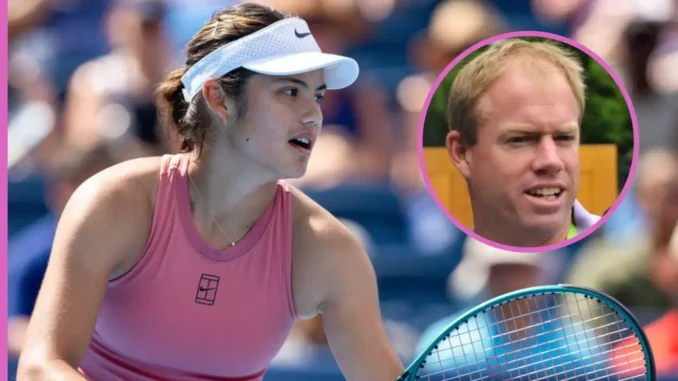
At 22, Emma Raducanu remains one of tennis’s most captivating figures, a British star whose 2021 US Open triumph as an 18-year-old qualifier etched her name in history. That fairy-tale victory in New York, where she dazzled with poise and precision, set an almost unreachable standard for her young career. Four years later, Raducanu is grappling with the realities of professional tennis—a landscape dominated by power and pace. Her recent third-round exit at the 2025 US Open against Elena Rybakina, a 6-1, 6-2 rout, laid bare the challenge of competing against the sport’s heavy hitters. Yet, insights from her former coach Mark Petchey offer a glimpse into the path forward, highlighting both the obstacles and the potential that define her journey.
Raducanu’s 2025 season has been a blend of promise and frustration. After a 2023 campaign derailed by wrist and ankle injuries, she has clawed her way back to No. 35 in the WTA rankings, with standout performances including a semifinal at the Citi Open and quarterfinals in Miami and Queen’s. Her fourth-round run at Wimbledon 2024 marked her best Grand Slam showing since her US Open win, a reminder of her ability to shine on big stages. But consistency has been elusive. Her first-round exit at the 2025 French Open and the recent US Open loss to Rybakina, a player known for her thunderous serves and groundstrokes, underscored a persistent struggle against the tour’s power players.
Mark Petchey, who coached Raducanu briefly in 2020 and again earlier this year, has been forthright about the challenge. “We’re in an era of big hitters,” he observed, pointing to players like Rybakina, Aryna Sabalenka, and Amanda Anisimova, whose aggressive, high-paced shots disrupt opponents’ rhythm. “These power players that make life difficult for Emma where they do rush her are going to make things tricky,” he said. Raducanu’s game, built on agility, redirection, and baseline control, thrives when she can dictate terms. But against opponents who unleash ferocious pace, she’s often forced into a defensive mode, a dynamic that Petchey sees as a critical area for growth.
Despite the setbacks, Petchey views these challenges as opportunities. “It’s just motivation for her to keep working on the things that she has been doing,” he emphasized. He believes Raducanu’s strength lies in her proactive approach: “Redirecting the ball, moving it around, trying to get the opponent to move before they get a chance to set on the ball.” This strategy, which powered her 2021 success, requires precision and confidence to counter the sport’s elite. Petchey also highlighted her physical constraints—at 5-foot-9, she lacks the towering frame of someone like Rybakina. “She can’t get taller; she’s not going to suddenly have a Rybakina serve that’s going to get her as many free points,” he noted. Instead, he advocates for sharpening her serve’s accuracy to set up her baseline game, a small but crucial adjustment that could yield significant results over time.
The US Open loss, Petchey argued, was a telling moment. “What it said to me is everything that I hope people can see about Emma’s style of play,” he reflected. It exposed her vulnerability to power but also underscored her potential for growth. “It’s not going to be easy to win another major,” he admitted, “but that’s what’s going to be so satisfying when she finally does.” Raducanu’s recent coaching shift to Francisco Roig, a veteran of Rafael Nadal’s team, signals her commitment to evolution. Roig’s technical expertise, praised by Toni Nadal as exceptional, is expected to refine her strokes and bolster her resilience against aggressive opponents. “Francis is a very good coach and a man who can help Raducanu to improve technically,” Toni Nadal said, emphasizing the need for balance in today’s power-driven game. Raducanu echoed this optimism, stating, “He’s obviously got a bank of experience, and I’m very excited to continue working with him.”
The road ahead is steep. Raducanu’s 0-6 record against top-10 players since her US Open title reflects the gap she must bridge. Yet, her 2025 season, with more matches played than ever before, signals progress. Tennis legend Martina Navratilova underscored the importance of this experience: “It all comes down to ‘can you do it during matches?’” she said, noting that Roig’s impact will be tested in competition. Raducanu’s next challenge awaits at the Korea Open in Seoul, where she’s entered via a wildcard, followed by WTA 1000 events in Beijing and Wuhan—crucial opportunities to face top competition.
Petchey remains a staunch supporter, praising Raducanu’s enduring drive. “Her desire to be able to do what she did back in 2021 is as great as I remember it,” he said, highlighting her “complete courage” and athleticism as unteachable gifts. The pressure of her early success weighs heavily, as Petchey acknowledged: “Having set the bar so high so early on in your career, every week you are measured not just by other people’s expectations but also your own.” Still, Raducanu’s story—of resilience, talent, and a relentless pursuit of growth—continues to captivate. Whether she can adapt to the era of power players and reclaim her place at the top remains uncertain, but her journey promises to be as compelling as ever.
Leave a Reply